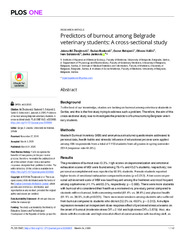Приказ основних података о документу
Predictors of burnout among Belgrade veterinary students: A cross-sectional study
| dc.creator | Živojinović, J.I. | |
| dc.creator | Backović, D. | |
| dc.creator | Belojević, G. | |
| dc.creator | Valčić, Olivera | |
| dc.creator | Soldatović, Ivan | |
| dc.creator | Janković, J. | |
| dc.date.accessioned | 2020-06-03T14:38:38Z | |
| dc.date.available | 2020-06-03T14:38:38Z | |
| dc.date.issued | 2020 | |
| dc.identifier.issn | 1932-6203 | |
| dc.identifier.uri | https://vet-erinar.vet.bg.ac.rs/handle/123456789/1812 | |
| dc.description.abstract | Background To the best of our knowledge, studies are lacking on burnout among veterinary students in Serbia, and this is the first study trying to address such a problem. Therefore, the aim of this cross-sectional study was to investigate the predictors of burnout among Belgrade veterinary students. Methods Maslach Burnout Inventory (MBI) and anonymous structured questionnaire addressed to personal data, health habits and stressful influence of educational process were applied among 496 respondents from a total of 1113 students from all grades in spring semester 2014 (response rate 44.6%). Results The prevalence of burnout was 43.3%. High scores on depersonalization and emotional exhaustion scales of MBI were found among 79.4% and 45.0% students, respectively; low personal accomplishment was reported by 50.5% students. Female students reported higher levels of emotional exhaustion compared to males (p = 0.012). A low score on personal achievement scale of MBI was least frequent among the freshmen and most frequent among sophomores (41.1% and 65.3%, respectively; p = 0.986). There were more students with burnout who considered their health as a worsened vs. pre-study period compared to students with no burnout, both concerning mental (61.4% vs. 38.6%) and physical health (61.1% vs. 38.9%; both p lt 0.001). There were more smokers among students who suffered from burnout compared to students who did not (52.0% vs. 48.0%; p = 0.013). A multiple regression revealed an independent dose-response effect of perceived stress at exams on the onset of burnout (moderate stress OR = 2.164 and high stress OR = 3.878). Also, students with the moderate and high stressful effect of communication with teaching staff, as well as, those with worse self-perceived physical and mental health had more than two times higher presence of burnout. Conclusions The prevalence of burnout among Belgrade veterinary students is relatively high. Primary prevention should be focused on the revealed predictors of burnout. | en |
| dc.publisher | Public Library of Science | |
| dc.rights | openAccess | |
| dc.rights.uri | https://creativecommons.org/licenses/by/4.0/ | |
| dc.source | PLoS One | |
| dc.title | Predictors of burnout among Belgrade veterinary students: A cross-sectional study | en |
| dc.type | article | |
| dc.rights.license | BY | |
| dcterms.abstract | Белојевић, Г.; Бацковић, Д.; Живојиновић, Ј.И.; Јанковић, Ј.; Валчић, Оливера; Солдатовић, Иван; | |
| dc.citation.volume | 15 | |
| dc.citation.issue | 3 | |
| dc.citation.spage | e0230685 | |
| dc.citation.other | 15(3): e0230685 | |
| dc.citation.rank | M22 | |
| dc.identifier.wos | 000535305100038 | |
| dc.identifier.doi | 10.1371/journal.pone.0230685 | |
| dc.identifier.pmid | 32208464 | |
| dc.identifier.scopus | 2-s2.0-85082195395 | |
| dc.identifier.fulltext | https://vet-erinar.vet.bg.ac.rs/bitstream/id/776/1811.pdf | |
| dc.type.version | publishedVersion |

